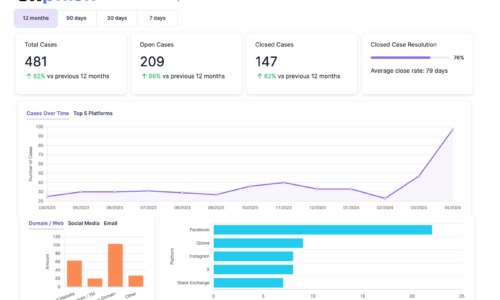Cybercriminals exploit fake social media ads due to the platforms’ extensive reach, precise audience targeting, and the inherent trust users have in the content they encounter. In 2022, the total cost of ad fraud was a staggering $81 billion, with projections indicating a surge to $100 billion by the end of 2023.
These deceptive ads provide a cloak of anonymity and cost-effectiveness for perpetrators, facilitating the rapid dissemination of scams. Additionally, the direct communication channels on these platforms allow for immediate and persuasive interactions with potential victims.
This, coupled with the swift spread of information on social media, makes such platforms a fertile ground for various fraudulent activities, from phishing to financial scams, necessitating vigilance from both users and platform operators.
Common Fake Social Media Ads targeting brands by Type
Brand or Staff Impersonation Schemes
In brand or staff impersonation schemes, fake ads convincingly replicate legitimate businesses’ look and messaging, or they pose as known individuals. These highly detailed ads, featuring accurate logos and familiar language, often promote fake offers or urgent requests, leveraging the trust associated with the impersonated entity.
Users, deceived by the ad’s authenticity, may divulge sensitive details or engage financially, not realizing they’re interacting with fraudsters. This not only harms the victims but also damages the reputation of the impersonated parties, emphasizing the need for vigilance and prompt reporting of such deceptive practices.
Phishing Scams
These ads cunningly entice users to click on malicious links, redirecting them to convincingly fraudulent websites. There, users are deceived into submitting personal information or login credentials under the guise of attractive offers. In the financial realm, these ads tempt users with exceptionally competitive rates on home loans, term deposits, and other financial products.
The websites perpetuate the facade of unbeatable rates, enticing users to divulge their details through a seemingly benign callback form. Subsequently, the fraudsters initiate contact, often resulting in the victims losing substantial sums, sometimes amounting to hundreds of thousands of dollars. All this financial devastation traces back to a single click on a deceptive social media ad.
Counterfeiting: advertising cheap knocks off as the real deal
Selling Counterfeit Products through fake social media ads is a sophisticated scam where criminals market bogus or non-existent items at alluring prices, exploiting consumer enthusiasm for bargains. These ads often resemble legitimate promotional content, featuring high-quality images and detailed descriptions that mask their fraudulent nature.
Consumers, lured by the seemingly authentic products and unbeatable prices, end up making purchases. Depending on the scammer’s approach, the buyer might receive a counterfeit product, often of markedly inferior quality and potentially hazardous, or they might receive nothing at all, with fraudsters providing fictitious tracking details or fabricating excuses for delays to prolong the scheme and avoid detection.
Data Harvesting and Surveillance
Scams cleverly disguise themselves as engaging surveys or enticing contests in social media ads, baiting users with the promise of rewards or participation in unique opportunities. However, these seemingly harmless activities serve a more sinister purpose: to covertly collect extensive personal data from unsuspecting participants. The information gathered ranges from basic contact details to more sensitive data like preferences, habits, and even financial information. Once harvested, this trove of data becomes a tool for malicious intents; it’s meticulously analyzed and utilized to craft targeted phishing schemes, adding a layer of personalization that increases their deception.
Alternatively, the data might be packaged and sold on dark web marketplaces to other criminals, who may use it for identity theft, financial fraud, or to build comprehensive profiles for future scams. This exploitation of personal data not only infringes on privacy but also exposes individuals to a spectrum of digital threats, emphasizing the need for vigilance and skepticism towards seemingly innocent online engagements.
How can brands defend against fake social media ads
Social Media Monitoring
Social media ad monitoring is a crucial defensive strategy for brands aiming to shield themselves from the damage inflicted by fake ads. By employing brand monitoring tools, companies can continuously scan social media platforms for unauthorized use of their trademarks, logos, or any misleading representation that could deceive customers. This real-time vigilance allows for the immediate identification and assessment of potential threats. Once a counterfeit ad is spotted, brands can swiftly enforce their rights through various channels. This might involve direct communication with the platform to remove the fraudulent content, or, in more severe cases, taking legal action against the perpetrators. Ensuring that the brand’s official social media profiles are verified with badges also adds an extra layer of authenticity, helping customers distinguish the real from the fake.
Enforcement: taking down fake social media ads
Brands can effectively take down fake ads from social media platforms by first setting up a vigilant monitoring system to detect fraudulent content swiftly. Upon identification, the brand should immediately report the ad to the respective platform, utilizing the platform’s official channels or contact points designated for handling intellectual property infringement or fraudulent content. It’s crucial to provide comprehensive documentation and evidence of the brand’s ownership and the ad’s fraudulent nature to facilitate a quick response. Additionally, brands may seek legal recourse, sending cease and desist letters to the offenders or initiating further legal actions if necessary. Establishing a direct line of communication with social media platforms can also expedite the takedown process, ensuring that fake ads are removed promptly to minimize potential damage to the brand and its consumers. Brandsec’s social media enforcement service and platform simplifies and speeds up the process of getting fake ads removed.
Listening to customers
Listening to customers provides an additional, invaluable layer of defense against fake ads. Brands should actively encourage their audience to report suspicious activities or ads that falsely associate with their name. This feedback loop not only aids in quickly identifying and addressing new threats but also fosters a sense of community and shared responsibility among customers. It’s equally important for brands to educate their customers on recognizing genuine brand communications and promotions. Regular updates and clear, consistent messaging through official channels can empower consumers to make informed decisions, reducing the likelihood of falling prey to fake ads. By combining vigilant monitoring, swift enforcement, and leveraging customer insights, brands can create a robust shield against the reputational and financial damage posed by counterfeit social media advertising.
About brandsec
brandsec is an Australian domain name management provider that offers online brand management solutions to corporate and government organisations. Our services include domain name management, domain name security, domain name policy development, dispute management, monitoring, and enforcement services. Additionally, brandsec offers a comprehensive online brand protection service that covers various platforms such as websites, social media, email, and online marketplaces. The service addresses issues related to counterfeiting, fakes, copyright infringement, intellectual property (IP) matters, piracy, and other intellectual protection-related issues.



